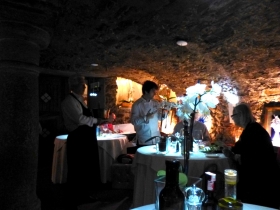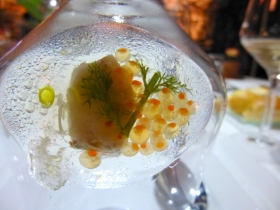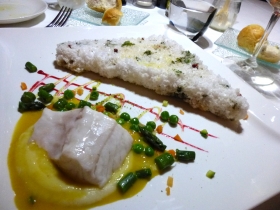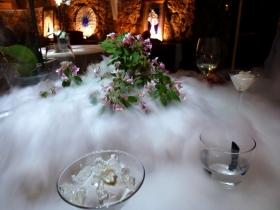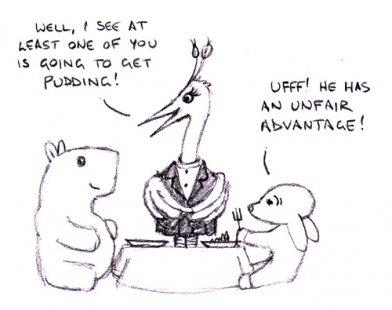Scene setting. We’re in Slovenia, a tiny country on the edge of the Balkans with Italy on one side and Austria on another. A long weekend is highly recommended, a week if you can spare it, and we’ve found at least one top-drawer restaurant for you.
A meal is an entire experience. So of course the incredibly friendly reception we had at Gostilna Pri Lojzetu was bound to help. From our cheerful Romanian waitress, our knowledgeable and enthusiastic sommelier, right through to Chef Kavcic’s wife who gave us a lift back to our hotel, I have to thank everyone for a memorable evening (and no, I didn’t give any hint that I was a food blogger).
But of course, it all counts for nothing if the food isn’t great. It was very good indeed.
Chef Tomaž Kavcic doesn’t make it easy for himself, finding out what each table is interested in and then tailoring a menu to suit them. That takes confidence, hospitality and a great deal of enthusiasm for your work. No menu appeared at any table, the staff explained everything as we went along, and chef was in and out of the dining room a lot.
There is a terrace for sunny lunches, but the main restaurant is a cosy and evocative wine cellar, with that unique wine cellar hum in the air. It’s a romantic setting, a room you’re most likely to be sharing with Italians as Pri Lojzetu is set in the countryside an hour from Ljubljana but only twenty minutes from the Italian border.
We began with a great deal of fun. Neatly set on the inside of an upturned wine glass was a cube of firm dentex (a local fish) set in a clear seawater jelly with garnish. This was a blinding good mouthful. We also enjoyed a little flowerpot of super-savoury beef ragu with a disc of baked pastry and clay on top, the literally earthy flavour going very well with the meat. Oh, and this came with a carnation. The carnation was filled with a zingy jot of herbal brew, a tiny hit that set up the beef nicely.
Our first proper dish was actually the only slight duffer of the night, some very good raw tuna and seabass with a slight muddle of local cheeses, orange dressing and tepid basil foam. Three raw shrimps had a gooey texture that coated the mouth like the morning after. I admit I was nervous at this point: copying fads without the execution?
So I was inexpressibly glad to find perfection in the next dish. Citrus cured beef, somewhere between a carpaccio and a braesola, on top of smooth local cheese mousse and a puddle of soothing pea puree, alongside a warm cube of the most excellent slow-cooked smoky pancetta on a salad of fennel and courgette.
And then I loved our next dish. A perfect scallop, coral and all, served in a sumptuous potato puree with fresh local asparagus. Seasoned to perfection (with seaweed salt? Not sure…), it was the most original use of scallops I’ve enjoyed in ages. This was followed by sea bass baked on a salt “stone”, a technique that was dramatic and also made for the best single piece of sea bass I’ve ever tasted, served with a sun-kissed citrus sauce.
A very odd thing happened after the gnocchi, delicious in a smoky cheese and wild asparagus sauce but rather too big for a tasting menu. We left some, to save room for the main as we told our waitress. Oh no, she explained, if you’re full we’ll stop here. In other words: dishes keep coming until you’ve had enough. It’s an admirable sentiment, but a bit left-field for such a fine tasting menu! We didn’t want to miss out so we tucked the gnocchi away with some difficulty and were rewarded with a modest portion of the foie gras with shredded apple and warm cheese underneath. Beautiful and surprising again.
Dry ice made its appearance alongside the dessert of citrus cream and gin jelly – this time beneath a branch of white blossom and filling the room with the herby scent of juniper when chef poured hot water from a sturdy watering can over it. Well, why not?
Eventually we paid about 70 Euros each for the menu, which is excellent value for such an entertaining and delicious tasting menu served with great enthusiasm and hospitality. The Slovenian wines we had paired with each course were memorably excellent, especially the local fizz that had me fooled into thinking I was swigging some rather good champagne. It’s only unfortunate that local production is probably too small to make exporting sensible. Boo.


